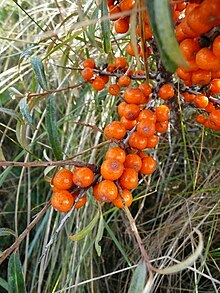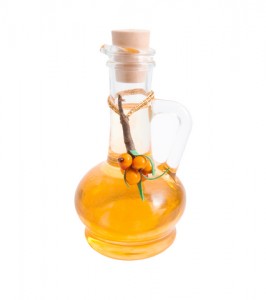The sea-buckthorns (Hippophae L.) are deciduous shrubs in the genus Hippophae, family Elaeagnaceae. The name sea-buckthorn is hyphenated here to avoid confusion with the buckthorns (Rhamnus, family Rhamnaceae). It is also referred to as "sea buckthorn", seabuckthorn, sandthorn or seaberry.
.JPG/170px-Hippophae_rhamnoides-01_(xndr).JPG) There are 6 species and 12 subspecies native over a wide area of Europe and Asia, including the Ladakh region (India) where it is used to make juices. More than 90 percent or about 1.5 million hectares of the world's sea buckthorn resources can be found in China where the plant is exploited for soil and water conservation purposes. The shrubs reach 0.5–6 m tall, rarely up to 10 m in central Asia, and typically occur in dry, sandy areas. They are tolerant of salt in the air and soil, but demand full sunlight for good growth and do not tolerate shady conditions near larger trees.
There are 6 species and 12 subspecies native over a wide area of Europe and Asia, including the Ladakh region (India) where it is used to make juices. More than 90 percent or about 1.5 million hectares of the world's sea buckthorn resources can be found in China where the plant is exploited for soil and water conservation purposes. The shrubs reach 0.5–6 m tall, rarely up to 10 m in central Asia, and typically occur in dry, sandy areas. They are tolerant of salt in the air and soil, but demand full sunlight for good growth and do not tolerate shady conditions near larger trees.The female plants produce orange berry-like fruit 6–9 mm in diameter, soft, juicy and rich in oils. The fruit are an important winter food resource for some birds, notably fieldfares. Leaves are eaten by the larva of the coastal race of the ash pug moth and by larvae of other Lepidoptera including brown-tail, dun-bar, emperor moth, mottled umber and Coleophora elaeagnisella.
Nutrients and potential health effects
Sea-buckthorn berries are edible and nutritious, though very acidic (astringent) and oily, unpleasant to eat raw, unless 'bletted' (frosted to reduce the astringency) and/or mixed as a juice with sweeter substances such as apple or grape juice.
 When the berries are pressed, the resulting sea-buckthorn juice separates into three layers: on top is a thick, orange cream; in the middle, a layer containing sea-buckthorn's characteristic high content of saturated and polyunsaturated fats; and the bottom layer is sediment and juice. Containing fat sources applicable for cosmetic purposes, the upper two layers can be processed for skin creams and liniments, whereas the bottom layer can be used for edible products like syrup.
When the berries are pressed, the resulting sea-buckthorn juice separates into three layers: on top is a thick, orange cream; in the middle, a layer containing sea-buckthorn's characteristic high content of saturated and polyunsaturated fats; and the bottom layer is sediment and juice. Containing fat sources applicable for cosmetic purposes, the upper two layers can be processed for skin creams and liniments, whereas the bottom layer can be used for edible products like syrup.Nutrient and phytochemical constituents of sea-buckthorn berries have potential value to affect inflammatory disorders, cancer or other diseases, although no specific health benefits have yet been proven by clinical research in humans.
The fruit of the plant has a high vitamin C content - in a range of 114 to 1550 mg per 100 grams with an average content (695 mg per 100 grams) about 15 times greater than oranges (45 mg per 100 grams)- placing sea-buckthorn fruit among the most enriched plant sources of vitamin C. The fruit also contains dense contents of carotenoids, vitamin E, amino acids, dietary minerals, β-sitosterol and polyphenolic acids.
Consumer products and medicine
 Sea-buckthorn fruit can be used to make pies, jams, lotions and liquors. The juice or pulp has other potential applications in foods or beverages. For example, in Finland, it is used as a nutritional ingredient in baby food. Fruit drinks were among the earliest sea-buckthorn products developed in China. Seabuckthorn-based juice is popular in Germany and Scandinavian countries. It provides a nutritious beverage, rich in vitamin C and carotenes. A specialty beer called Tyrnilambic Baie d'Argousier has been produced at the Cantillon Brewery in Brussels exclusively for the Finnish Market.
Sea-buckthorn fruit can be used to make pies, jams, lotions and liquors. The juice or pulp has other potential applications in foods or beverages. For example, in Finland, it is used as a nutritional ingredient in baby food. Fruit drinks were among the earliest sea-buckthorn products developed in China. Seabuckthorn-based juice is popular in Germany and Scandinavian countries. It provides a nutritious beverage, rich in vitamin C and carotenes. A specialty beer called Tyrnilambic Baie d'Argousier has been produced at the Cantillon Brewery in Brussels exclusively for the Finnish Market.For its troops confronting extremely low temperatures, India's Defence Research Development Organization established a factory in Leh to manufacture a multi-vitamin herbal beverage based on sea-buckthorn juice. The seed and pulp oils have nutritional properties that vary under different processing methods. Sea-buckthorn oils are used as a source for ingredients in several commercially available cosmetic products and nutritional supplements.
 Different parts of sea-buckthorn have been used as traditional therapies for diseases. As no applications discussed in this section have been verified by Western science and sufficient clinical trial evidence, such knowledge remains mostly unreferenced outside of Asia and is communicated mainly from person to person, therefore falling into the category of folk medicine.
Different parts of sea-buckthorn have been used as traditional therapies for diseases. As no applications discussed in this section have been verified by Western science and sufficient clinical trial evidence, such knowledge remains mostly unreferenced outside of Asia and is communicated mainly from person to person, therefore falling into the category of folk medicine.Grown widely throughout its native China and other mainland regions of Asia, sea-buckthorn is an herbal remedy reputedly used over centuries to relieve cough, aid digestion, invigorate blood circulation and alleviate pain. Bark and leaves may be used for treating diarrhea and dermatological disorders. Berry oil, taken either orally or applied topically, may be used as a skin softener.
For its hemostatic and anti-inflammatory effects, berry fruits are added to medications for pulmonary, gastrointestinal, cardiac, blood and metabolic disorders in Indian, Chinese and Tibetan medicines. Sea-buckthorn berry components have potential activity against cancer and dengue virus. Fresh juice, syrup and berry or seed oils may be used for colds, fever, exhaustion, as an analgesic or treatment for stomach ulcers, cancer, and metabolic disorders.
Sea-buckthorn Oil
 Oil can be extracted from either the seeds or the pulp of the fruit. Oils from sea-buckthorn seeds and pulp differ considerably in fatty acid composition. While linoleic acid and α-linolenic acid are the major fatty acids in seed oil, sea- buckthorn pulp oil contains approximately 65% combined of the monounsaturated fatty acid, palmitoleic acid, and the saturated fatty acid, palmitic acid. Few other vegetable oils contain a similar quantity of these fatty acids. Both the seed and pulp oils are rich in tocopherols, tocotrienols and plant sterols. In addition, the pulp oil contains especially high levels of carotenoids.
Oil can be extracted from either the seeds or the pulp of the fruit. Oils from sea-buckthorn seeds and pulp differ considerably in fatty acid composition. While linoleic acid and α-linolenic acid are the major fatty acids in seed oil, sea- buckthorn pulp oil contains approximately 65% combined of the monounsaturated fatty acid, palmitoleic acid, and the saturated fatty acid, palmitic acid. Few other vegetable oils contain a similar quantity of these fatty acids. Both the seed and pulp oils are rich in tocopherols, tocotrienols and plant sterols. In addition, the pulp oil contains especially high levels of carotenoids.Due to its unique botanical and nutritional properties, and there being no reported evidence of sea-buckthorn oil causing adverse reactions or negative side effects, the oil is also used as a natural agent that may benefit diseases of mucou membranes, including Aphthous ulcers, esophagitis, acid reflux, and peptic ulcers, as well as dermatological diseases and skin conditions.
In Russia and China, pulp oil may also be used topically to treat skin burns from radiation. Due to its ability to absorb ultraviolet rays, pulp oil is purported to reduce risk of radiation burns for Russian astronauts working in space.
Currently, cosmetic companies are adding sea-buckthorn oil to anti-aging preparations for skin rejuvenation and accelerated healing properties. It is also being used topically as a natural treatment for eczema, acne rosacea, acne and acne scars, and as a lotion for minimizing stretch marks.
Source, Images: http://en.wikipedia.org/wiki/Sea-buckthorn









0 comments:
Post a Comment